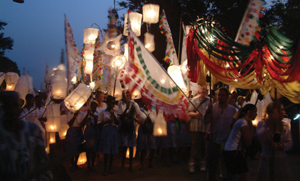Ruth Oakley describes an artistic critique of indulgence in London’s square mile.

Shake your tail feathers, masquerade, allow giant creatures to emerge from the workshop, break out the best of what is left in the kitchen and come together for the most spectacular of street parties... before giving way to sobriety, abstinence and the rather greyer period of Lent before Easter. These are the Catholic roots of carnival – the ‘fat’ in the Tuesday of ‘Mardi Gras’, the creative acknowledgment in the cultural calendar of abundance and living large.
This summer the City of London Festival is presenting a carnival that reinterprets the idea of indulgence, by picking through the leftovers of the Square Mile. The festival has an ongoing focus on the environment and sustainability, and is choosing to launch its 2009 programme with an opening procession of hundreds of children and young people presenting an ecological carnival arts quest, ‘The Art of Recycling’. Dozens of groups are working with festival artists to create sculptural art works, puppetry, mask and costume, manufactured entirely from waste generated by the City. Artists Katie Barton, Mandeep Dhiman, Cassi Hill and Alice Lodge are the creative impresarios: textiles specialists with imaginations that can take a few bags of plastic bottles left over from the London Marathon and create a parallel universe of sea creatures or exotic flower gardens. The team at the City of London’s Waste Transfer Unit are both the enthusiasts and the logistical backbone of the project, gathering and hoarding as many interesting items as they can and even deciding to decorate their mechanised street sweepers to join the parade.
The project has virtually no materials budget and seeks to draw out richness of creativity with what is available and understanding of where the materials have come from. It aims to unlock the City to young people, a startling number of whom, even those from neighbouring boroughs, have never found reason to visit the Square Mile. The City, while it struggles under a fog of financial reckoning, remains the oldest and most architecturally resplendent part of London, with much to offer, and there is great support and collaboration there, including closure of major streets, to make way for this procession of young people and their whimsy of waste.
Carnival has great potential to evolve. It is responsive to themes and ideas, spans art forms, gives rise to a variety of artistic skills and provides multitudinous possibilities for young people to get involved. Contemporary carnivals in the UK such as Notting Hill or Edinburgh Hogmanay may have little to do with Lenten origins, but the commonality is spectacle, celebration of community and an extraordinary giving over of the streets to artistic expression. It also has the propensity to make a powerful fanfare of statements such as “look at who we are”, “we’re proud of our community”, “we don’t normally dress in Lycra unitards but we’re very much enjoying ourselves”, and “we aren’t normally allowed to be here.” Here’s hoping that ‘The Art of Recycling’ is able to reflect all these statements and more with its flotilla of rubbish.
The City of London Festival’s Opening Procession takes place on 19 June.
Ruth Oakley programmes both education and free events for the City of London Festival.
e: ruth.oakley@colf.org; w: http://www.colf.org



